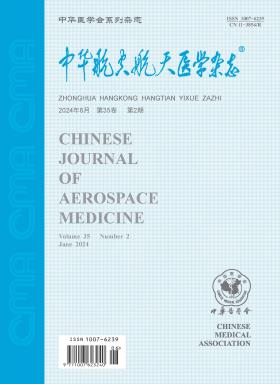The effects of reverse operation in simulated carrier aircraft landing on mental workload
引用次数: 1
Abstract
Objective To compare the subjects' scores of National Aeronautics and Space Administration-task load index (NASA-TLX), the indexes of ECG and performance between the reverse target tracking task and the ordinary target tracking task which simply simulate"reverse operation"of carrier aircraft landing, and to preliminarily investigate the effect of"reverse operation"on pilot's mental workload and its influence factors. Methods Twenty-five young male subjects accomplished the reverse and the ordinary target tracking tasks with two degrees of difficulty. ECG signals were recorded during the resting period before the task, periods of each task and the resting period after the task. Each subjects filled in NASA-TLX scale after the completion of each task and had a score feedback for each task. The scores of NASA-TLX and the indexes of performance were analyzed by analysis of variance (ANOVA) in 2×2 factorial design. The indexes of ECG were analyzed by Friedman M test and the multiple comparisons were carried out by LSD-t test. Results The scores of NASA-TLX and the average tracking distance of the reverse target tracking task were higher than those of the ordinary target tracking task (F=21.70, 16.14, P<0.05) and the highest appeared in the reverse dual task (F=6.67, P<0.05). HR also had the corresponding change (χ2=34.87, P<0.05), but the indexes of HRV had no significant differences. Conclusions Mental workload of the reverse operation task is higher than that of the ordinary operation task if the other conditions are the same. The reverse operation impacts mental workload severer when more information processing is required. Mental demand, physical demand and frustration level are the major influence factors of causing high mental workload in reverse operations. Key words: Workload; Cognition; Habituation, psychophysiologic; Work capacity evaluation; Electrocardiography模拟舰载机降落时逆向操作对心理负荷的影响
目的比较美国航空航天局任务负荷指数(NASA-TLX)、反向目标跟踪任务与单纯模拟舰载机着陆“反向操作”的普通目标跟踪任务的心电指标和表现,初步探讨“反向操作”对飞行员心理负荷的影响及其影响因素。方法25名年轻男性受试者分别完成两种难度的目标跟踪任务。记录任务前静息期、各任务周期和任务后静息期的心电信号。每个被试在完成任务后填写NASA-TLX量表,并对每个任务进行得分反馈。采用2×2因子设计方差分析(ANOVA)对NASA-TLX评分及各项绩效指标进行分析。心电图各项指标采用Friedman M检验,多重比较采用LSD-t检验。结果反向目标跟踪任务的NASA-TLX得分和平均跟踪距离均高于普通目标跟踪任务(F=21.70、16.14,P<0.05),其中反向双任务得分最高(F=6.67, P<0.05)。HR也有相应变化(χ2=34.87, P<0.05),但HRV各指标差异无统计学意义。结论在其他条件相同的情况下,逆向操作任务的心理负荷高于普通操作任务。当需要处理更多的信息时,逆向操作对心理负荷的影响更大。心理需求、生理需求和挫折程度是造成逆向操作高心理负荷的主要影响因素。关键词:工作量;认知;习惯化,psychophysiologic;工作能力评价;心电描记法
本文章由计算机程序翻译,如有差异,请以英文原文为准。
求助全文
约1分钟内获得全文
求助全文
来源期刊

中华航空航天医学杂志
航空航天医学
自引率
0.00%
发文量
2962
期刊介绍:
The aim of Chinese Journal of Aerospace Medicine is to combine theory and practice, improve and popularize, actively advocate a hundred flowers bloom and a hundred schools of thought contend, advocate seeking truth from facts, promote the development of the related disciplines of aerospace medicine and human efficiency, and promote the exchange and penetration of aerospace medicine and human efficiency with other biomedical and engineering specialties.
Topics of interest for Chinese Journal of Aerospace Medicine include:
-The content of the journal belongs to the discipline of special medicine and military medicine, with the characteristics of multidisciplinary synthesis and cross-penetration, and mainly reflected in the aerospace industry, aerospace flight safety and efficiency, as well as the synthesis of special medicine, preventive medicine, environmental medicine, psychology, etc.
-Military aeromedicine (Air Force, Navy and Army aeromedicine) and civil aeromedicine, with a balance of aerospace medicine are the strengths of the journal.
-The change in aerospace medicine from a focus on promoting physiological compensatory adaptations to enhancing human performance under extreme environmental conditions is what the journal is helping to promote.
-The expansion of manuscripts in high altitude medicine is also a special emphasis of the journal.
 求助内容:
求助内容: 应助结果提醒方式:
应助结果提醒方式:


